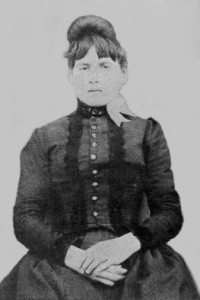Greenbrier County, West Virginia was a densely populated area. Nothing out of the ordinary ever occurred there until 1897, when a shocking death created an outburst and made headlines. Elva Zona Heaster was victim to a horrible murder that had originally been judged as “death by natural causes.”1
In 1895, Heaster gave birth to an illegitimate child. The next year she met Erasmus Stribbling Shue, and the couple soon married and were known to be inseparable. Despite the love the couple had for one another, Mary Jane Robinson Heaster, Zona Heaster’s mother, was not very impressed by Erasmus Shue, and disapproved of their marriage. Despite this, the couple continued to live together.

Erasmus Shue had initially moved to Greenbrier County to work as a blacksmith. Months went by and the couple seemed to live a normal life. On January 23, 1897, Shue sent a young boy that worked with him in the blacksmith shop to run an errand for him. The young boy obliged and walked to the couple’s house to do as he was told. Upon entering the house, the boy found Heaster lying at the bottom of a stairwell. Knowing that Heaster was dead, the young boy ran to his mother and notified her of what he had seen. The local doctor, police, and Shue were notified. Shue was the first to arrive on the scene; he carried his wife up the stairs and laid her on their bed, where he proceeded to dress her. His actions were very out of the ordinary considering the custom was for the ladies of the community to dress her in appropriate burial wear. Shue dressed her in a stiff-collared dress and a large veil. The local doctor, Dr. Knapp, was sent to examine the body, but was having difficulties since Heaster’s husband refused to let go of her, cradling her head and hysterically crying. As a result, Dr. Knapp declared her cause of death to be “an everlasting faint,” but then changed his statement to “childbirth.” What was particularly interesting was that Heaster had told no one that she was pregnant, nor did she appear to have signs or symptoms of pregnancy. Soon after, Heaster’s mother was notified and she immediately blamed Shue for Zona’s death.2
Mary Jane, Heaster’s mother, began praying and asking God to give her the name of the person guilty of her daughter’s murder. About four weeks after the death of her daughter, Mary Jane claimed to have had visions of a ghostly appearance telling her that Shue had killed her daughter. This occurrence happened four nights in a row, and began to make Mary Jane very ill. She decided to take her testimony to a prosecutor, John Alfred Preston. The prosecutor was hesitant about taking her case, but decided to do research on his own before believing Mary Jane. He went around the town asking for testimonies on the matter and found that Dr. Knapp admitted to not having been able to conduct a complete examination of the body. Neighbors noticed that during the viewing of Heaster, Shue never left the side of the coffin and didn’t let anyone look at her closely. As the pieces of the mysterious death finally fell into place, the prosecutor decided to take on the case. The prosecutor was able to obtain a warrant that allowed the body to be exhumed for re-examination.3
After a complete autopsy was performed, doctors found that Heaster’s neck had been broken and the bruising around her neck indicated that her windpipe had been severely crushed, as if she had been strangled. After the autopsy had been concluded, Shue was arrested and taken into custody for a later trial.4
The trial started on June 23, 1897, and lasted for eight days before the jury decided on a verdict. During the trial, the prosecutor tried to avoid using Mary Jane’s testimony due to the misunderstanding the jury might have. Regardless of these allegations, Mary Jane went ahead and revealed how she knew that Shue had murdered her daughter. Shue’s attorney immediately rejected the idea claiming that Mary Jane was crazy and unstable. The jury, however, found her story credible but did not mention it again after the first statement. The evidence against Shue was overwhelming and on the last day of the trial the jurors finally decided on a verdict. Ten of the twelve jurors voted on execution, but since it was not a unanimous decision, Shue was eventually sentenced to life in prison for first degree murder of Elva Zona Heaster.5
After the sentence, Shue was sent to prison, but the overwhelming disagreement on behalf of the community caused an outraged. Greenbrier County citizens felt that Shue should be hanged for his crime. On July 11, 1897, an angry mob gathered and threatened to lynch Shue, but the sheriff heard what was happening, and hid Shue in the woods before the mob could reach him. The Sheriff calmed the mob and eventually everyone went home.6
On July 13, 1897, Shue was placed in the state penitentiary where he eventually died of natural causes on March 13, 1900.7
The ordeal of the Greenbrier Ghost has sparked interest in many paranormal investigators and has made West Virginia a popular tourist attraction. No real evidence has been found on the Greenbrier ghost that Mary Jane claimed revealed her daughter’s murderer. The case is particularly interesting because at the time, investigators could not have revealed the murderer, due to the obvious lack of technology or forensic evidence. The only person that could have any other reliable testimony on the case would be the young boy that found Zona Heaster dead. From what was uncovered, the case can only be concluded as “Murder Solved by Ghost.”
- Katie Lyle, Man Who Wanted Seven Wives: The Greenbrier Ghost and the Famous Murder Mystery of 1897 (Charleston, W. Va: Quarrier, 1999), 6. ↵
- Katie Lyle, Man Who Wanted Seven Wives: The Greenbrier Ghost and the Famous Murder Mystery of 1897 (Charleston, W. Va: Quarrier, 1999), 6. ↵
- “EDITORIAL: West Virginia ghost stories recounted in new book,” Charleston Gazette, The (WV), November 01. Newspaper Source, EBSCOhost (accessed October 10, 2017). ↵
- Mike Conley, “Mike Conley’s Tales of the Weird: Ghost brings murderer to justice,” McDowell News, The (NC), August 27. Newspaper Source, EBSCOhost (accessed October 10, 2017). ↵
- Katie Lyle, Man Who Wanted Seven Wives: The Greenbrier Ghost and the Famous Murder Mystery of 1897 (Charleston, W. Va: Quarrier, 1999), 6. ↵
- “EDITORIAL: West Virginia ghost stories recounted in new book,” Charleston Gazette, The (WV), November 01. Newspaper Source, EBSCOhost (accessed October 10, 2017). ↵
- Mike Conley, “Mike Conley’s Tales of the Weird: Ghost brings murderer to justice,” McDowell News, The (NC), August 27. Newspaper Source, EBSCOhost (accessed October 10, 2017). ↵



96 comments
Hali Garcia
I was interested just by reading the title. I never thought a ghost could solve a murder but now I guess it can happen. What struck me the most was how distraught her husband seemed but then when he would not allow the doctor to fully examine her that made me suspicious. I wonder what else could have been proved if other technology and forensic studies were developed at that time.
Diamond Davidson
This story actually caught my attention just by the title. This was very interesting and an amazing story that I never heard about. It was very abnormal from when doctor changed his theory on what happen to Heaster and when the prosecutor actually believed Mary Jane’s testimony and was willing to figure out the death of her daughter because of her ghost story. However, I believed there’s still some unsolved mysteries about Shue’s reaction to when he found out she died to the examination and when he was by her coffin. Overall, this is a great mysterious/ crime story.
Madison Downing
This article was a fascinating read and I can’t believe that they actually put down that this murder was solved by a ghost. I can’t believe that this man would kill his own wife and go out of his way to make sure no one actually seen her and was able to tell what happened. I’m glad that the mother never gave up trying to find out what actually happened and officially put Erasmus behind bars. A part of me wished that he did die because what he did was despicable but I believe the Sheriff was right and the situation shouldn’t have been handled that way.
Jocelyn Moreno
It’s crazy that a ghost helped solve a murder! but at the same time, it is so interesting how they used her mother’s dreams seriously because honestly, the majority of the people wouldn’t. This was such interesting case / article to read, i enjoyed it very much!!
Aneesa Zubair
I had a lot of fun reading this article! It is unusual that the prosecutor actually believed Mary Jane’s testimony, but oddly enough, that turned out to be a good thing because it helped lead them to the murderer. It looks like a lot has remained undiscovered about the case, like Shue’s motives, as well as forensic evidence that would be easier to obtain in modern times. This makes the case even more mysterious and intriguing.
Emily Jensen
What an interesting read, a ghost that helped solve her own murder through her mother? Definitely a unique story! I can see why it would be suspicious that Erasmus refused to leave Heaster’s body, even after she was removed from the house to the funeral home. I was slightly surprised to read that the prosecutor agreed to investigate the case after Heaster was buried, especially going off a ghost story from her mother.
Nathalie Herrera
Although Elva Zona Heaster’s death was tragic it is interesting read the events that led to finding her murderer. Her mother, Mary Jane, had dreams that revealed who was responsible for the murder of her daughter, that being her husband, Erasmus Shue. Personally, I don’t believe in ghosts but is interesting to read the effects of this on the mother, jury and others. Although this could have been a way for the mother to get the investigators back into the case of her daughter’s death to prove Shue was the murderer, it is interesting to see that in the end it did work.
Alexandra Rodriguez
Whether or not ghosts are real is always a controversy, but it managed to convince twelve jurors that a mad was guilty and almost put to death for it. While the ghost story could be made up because of a biased opinion towards Shue, it is quite odd that he managed to keep all the officials from investigating thoroughly before burying her. It was only after the vision that they were able to collect the evidence to find Shue guilty of murder.
Karina Cardona Ruiz
It’s so sad that the couple was happily married one moment and then Shue brought an end to it. The way Shue reacted to his wife’s death was suspicious especially the part where he began to dress her for her funeral: I don’t think anyone in their right mind would be able to dress their deceased loved one. I’m curious as to what motivated Shue to kill his wife. Was it money? Was he not ready to have a child with her? Was he no longer fond of her? From reading the article it just seems as though he randomly decided to murder her one day. It’s weird to think that Elva Heaster’s death would’ve remained accounted to natural causes had Mary Jane not had her visions/dreams about her daughter’s death.
Didier Cadena
This was a very interesting article. The whole situation is a strange one, but that is probably why the case is so memorable. It seems hard to believe that it was an actual ghost who told Elvas’s mother about it, but anything can happen. I do wonder what caused Shue to kill Elva. The way that the article was written made it both fun and interesting to read.